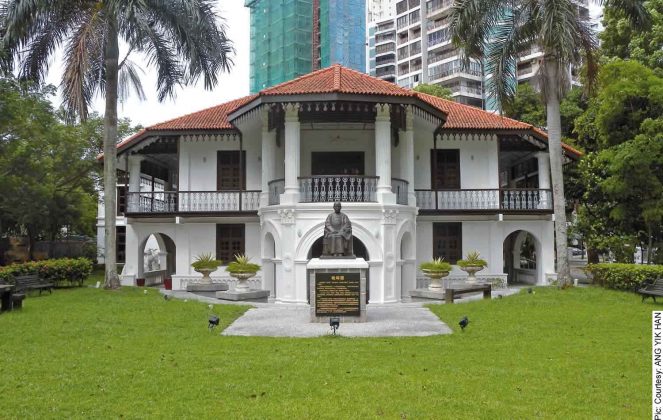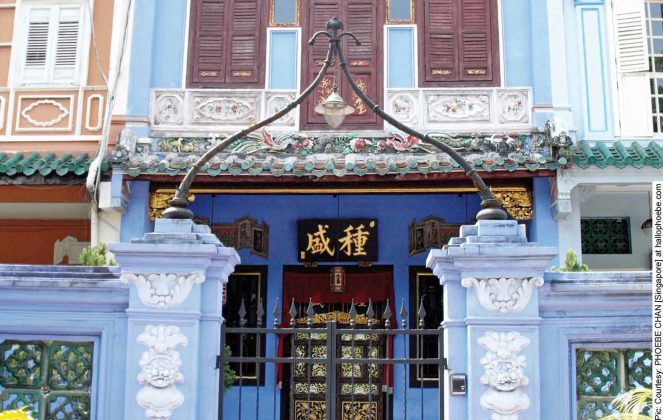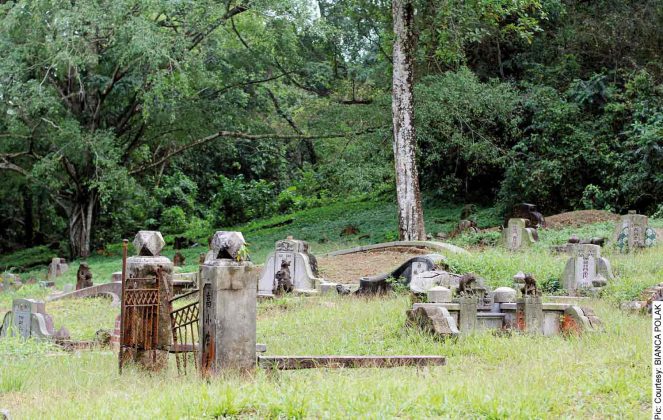Even before cracking open a guidebook, we have an impression of the place we’re about to visit. Nimble geishas serving tea in an ochaya loom up when someone mentions Kyoto; New York brings out images of verve and blinding neon; Greece, of ruins and blue sea. There’s nothing wrong with these pre-programmed images until you treat them as the only ones a destination can offer. Hear The Danger of a Single Story by Chimamanda Adichie, an acclaimed Nigerian author and you’ll know what I mean.
When friends shared selfies atop Marina Bay Sands, advertorials flashed fabulous shopping malls on Orchard, and travel episodes featured thumping nightlife at Clark Quay, I assumed that’s all there is to Singapore. For the better part of my four year expat life, I showed my back to the incredible 7,100 heritage sites packed into this island nation because I too was feeding off a single story. To spare you a similar fate, here are a few of my favourites.
Thian Hock Keng Temple
With the financial district in its vicinity—towering skyscrapers and dark-suited office workers milling about on streets—the location of Singapore’s oldest temple on Telok Ayer Street not only looks incongruous but also amusing.
Even more amusing is the fact that before the land reclamation of 1880, Telok [meaning bay] Ayer [meaning water] was the seafront. Early immigrants from the Fujian Province of China, sailing across the turbulent South China Sea, would visit this site to offer thanks to Ma Zhu [Goddess of the Sea] for their safe passage.
The 1820s modest joss house was later built into a temple in 1842 at a cost of 30,000 Spanish dollars. The entire structure was assembled without nails by skilled Chinese craftsmen and all the materials including the building’s main supporting pillars and the idol were imported from China, making it the most authentic Chinese temple in Singapore.
On my first visit, to hear a Nanyin concert at its premises a few weeks ago, I was most intrigued by the temple’s architecture—the three-hall complex with multiple courtyards, decorations on the roof ridges and the magnificent dragon and phoenix reliefs made out of colorful broken porcelain using chien-nien technique.
If not for the architectural details, visit the temple to experience the brash juxtaposition of the past and the present.
Sun Yat Sen Memorial Hall
“This is Singapore’s hidden gem,” says tour guide Mary Cooper. Despite its unparalleled historical importance, tourists don’t know much about this charming two-storied colonial-style villa in Balestier, named ‘Wan Qing Yuan’ or ‘serene sunset garden’ by Teo Eng Hock, a rubber magnate after he bought it in 1905 for his mother to retire.
“But mother preferred the bustle of Chinatown to the quiet suburbs, which Balestier was in those days and the villa remained largely unused,” continues Mary, “until 1906, when Teo offered the villa to Sun Yat Sen for repurposing it as the Southeast Asian base for his revolutionary activities, to overthrow the Qing dynasty in China.”
Milestone battles were planned here, a breakthrough coming from Wuchang Uprising in 1911, birthing the Republic of China.
Mary pauses before a black and white photograph of the founders of Tong Meng Hui’s Singapore chapter. “Here’s Sun in the middle in a Zhongshan suit, flanked by a Teo Eng Hock, a Peranakan, in western attire and Tan Chor Lam with his shaved head and pigtail, which he had cut off later.”
Visit this villa to explore the artefacts, rare photographs, calligraphy and hear enthralling stories from Mary, to get a peek into the lives and political works of the revolutionaries who transformed the future of China.
Baba House
If you’ve been tripping through Chinatown, had your fill of chilli crab with chilled beer, seek refuge from the afternoon sun in this beautifully restored shop-house from 1890. This place was once the ancestral home of Wee Bin, a wealthy Peranakan shipping magnate.
The history of Peranakans goes back to the 15th century, when Chinese merchants settling in the Straits of Malacca began integrating traits of local Malayan culture into their own, resulting in a hybrid culture. By the 19th century, Peranakans were working as intermediaries between mainland Chinese traders and colonial rulers, thus amassing immense wealth, which they spent lavishly on building decorative houses such as Baba house.
Standing at the courtyard, Chia Hock Jin, our tour guide walks us through the architectural elements of the house’s blue façade—twin lanterns bearing the resident’s name, insignias with golden Chinese characters bearing the name of the house, pastel- coloured motifs of peonies and phoenixes signifying longevity and peace.
The richly decorated half-doors called pintu pagars lead to a luxurious living room with ornately carved Qing dynasty furniture. “This is where the patriarch entertained his guests,” says Hock Jin. The family hall—domain of women and children—houses ancestral tablets, eating area and an airwell. The kitchen is lined with lacquered meal containers, woks, grinding stones, dessert moulds, mortar and pestle among others.
When Hock Jin leads us to the flamboyant bridal chamber on the second floor, it is not the carved and gilded canopied bed with fertility symbols that catches the group’s fancy, but a tiny peephole on the polished floor allowing an unobstructed view of the living room. “So a Peranakan wife could see all who came to meet her husband,” says Hock Jin, twinkling at us.
Good to know
Admission Fee: With the exception of Sun Yat Sen Memorial Hall [S$ 4], none of the heritage sites mentioned here require admission fee.
Guided Tours: Visits to Baba House are strictly by appointment. To book a slot in the next free hour-long heritage tour, write to ba*******@nu*.sg
Not mandatory, but definitely recommended are the free English guided tours of Sun Yat Sen Memorial Hall from Tuesday till Friday at 2pm and on Saturdays and Sundays at 3pm.
To join the Brownies on one of their fantastic and well-researched guided walks, keep watching the ‘Events’ space on http://bukitbrown.com/main/
Getting there: Use Singapore’s cheap, air-conditioned public transportation to reach the sites and meet locals while you do it. Trust Google maps to lay out the route to the sites from your location
Keep a subway map handy [free at all MRT stations] and download mytransport.sg app to get real-time island-wide bus arrival information.
All failing, get yourself a cab. Not only are the fares reasonable, Singapore cab drivers are quite amicable and might ply you with local trivia and travel tips!
Visit Baba House to admire the potpourri of Chinese symbolism, Feng Shui and the intriguing mix of oriental and western architecture that contribute to the hybrid design of Peranakan homes, making them so wonderfully unique.
Bukit Brown Cemetery
Would you spend your weekend morning in company of the deceased? I did, when this 90-year-old, largest Chinese municipal cemetery outside China with 100,000 graves in its wake was put as a site at risk on 2014 World Monument Watch List.
This announcement pumped a sense of triumph into the ‘Brownies’—as the passionate volunteers rallying to conserve this pocket of Singapore’s heritage and biodiversity, call themselves. Part of the cemetery is making way for an eight-lane road, which mandates the exhumation of approximately 5,000 graves.
“Notice the 12 rays of sunlight etched on the headstone, indicating his longtime assistance with Sun Yat Sen’s Kuomintang,” says Chew Keng Kiat, a Brownie and our tour guide, at Tan Boon Liat’s grave, before moving on to the resting place of Singapore’s other pioneering leaders.
We’ve been grave-hopping through a festoon of rain trees, shrubs and grass that have colonised these 233 acres of undulating terrain over decades. The sky is clear but the sun barely trickles through the dense vegetation. The overpowering hum of cicadas has set the tone for the day. A site so tranquil is hard to imagine in the heart of Singapore and a perfect antidote to the city’s hubbub.
Visit the cemetery, better yet, join the Brownies to admire the architecture of the graves—their shapes, designs, decorations using sculptures that were meant to guard and assist the deceased in afterlife such as lions, Sikh guards, ‘jade girl’ and ‘golden boy’ and elaborate reliefs depicting stories on mythology, legends and filial piety.
This was first published in the February 2014 issue of Complete Wellbeing.






